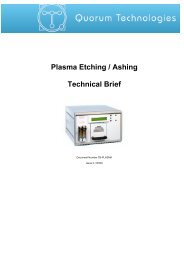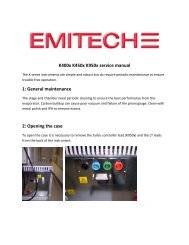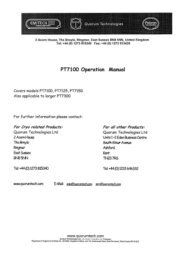SC7640 Auto/Manual High Resolution Sputter Coater Operating ...
SC7640 Auto/Manual High Resolution Sputter Coater Operating ...
SC7640 Auto/Manual High Resolution Sputter Coater Operating ...
You also want an ePaper? Increase the reach of your titles
YUMPU automatically turns print PDFs into web optimized ePapers that Google loves.
OM-<strong>SC7640</strong> Maintenance<br />
7 Maintenance<br />
For technical and applications advice plus our on-line shop for<br />
spares and consumable parts visit www.quorumtech.com<br />
7.1 Maintenance - General<br />
WARNING<br />
HAZARD TO HEALTH!<br />
Potentially lethal voltages are used in this equipment.<br />
Before making / breaking connections to the equipment, ensure power<br />
is switched off on the the Electronics unit.<br />
(a) The procedures listed in this chapter should only be done by persons who have had training<br />
and who have achieved a satisfactory knowledge of the necessary skills and techniques.<br />
(b) If repairs entail the dismantling of any part of the vacuum system, care must be taken to<br />
ensure that it is not contaminated (by dust or fingerprints).<br />
(i) Always wear disposable plastic gloves.<br />
(ii) Do NOT handle internal surfaces.<br />
(iii) Whenever possible, cover to protect against dust.<br />
7.2 Cleaning<br />
Use a damp cloth or proprietary equipment cleaner to remove surface grime from the outer<br />
surfaces of the cabinet and vacuum chamber. Finish with a dry lint free cloth to remove smearing.<br />
7.2.1 Vacuum Chamber Cleaning<br />
Cleaning of the vacuum chamber is required if the interior of the chamber becomes contaminated,<br />
cleaning on a regular basis is unnecessary. The fact that the glass walls of the chamber becomes<br />
coated with target material and the sample cannot be seen, should not normally be considered<br />
reason to clean the system.<br />
If the system is contaminated by handling or air-bourne pollution, carry out the following procedure.<br />
For cleaning use a nylon abrasive pad (Scotchbrite or similar) and Cleaning fluid (Isopropanol or<br />
menthyl alchol).<br />
(a) Ensure power, water and gas supplies to the sputter coater are set to OFF.<br />
(b) Remove all electrical, gas, water and vacuum connections from the rear of the instrument.<br />
Move the sputter coater to a clean working area.<br />
(c) Raise the top plate to expose the target. Disassemble the glass cylinder and ‘L’ gaskets from<br />
the cabinet assembly.<br />
(d) Lightly abrade all the accessible interior surfaces of the vacuum chamber to remove any<br />
deposits (not the target) and the glass cylinder, to remove any deposits. Finish with a lint free<br />
tissue moistened with isopropanol. Cover cleaned components to prevent further<br />
contamination.<br />
(e) The target is self cleaning in use and should not require attention. If the target is damaged,<br />
replace the target, see section 7.3.<br />
(f) The vacuum and gas tubing cannot be readily cleaned, if these items are suspect or showing<br />
signs of ageing they should be replaced.<br />
(g) Reassemble the vacuum chamber components.<br />
(h) Reconnect the electrical and gas tubing connections from the Top Plate assembly at the rear<br />
of the cabinet.<br />
(i) Return the sputter coater to its working position. Reconnect the electrical, vacuum, gas and<br />
water connectors to the cabinet rear panel.<br />
(j) When taking the system back into service carry out the Test Procedure (see chapter 6.1),<br />
this will ensure the system is thoroughly dried out.<br />
Issue 1 31 <strong>SC7640</strong> <strong>Sputter</strong> <strong>Coater</strong>






